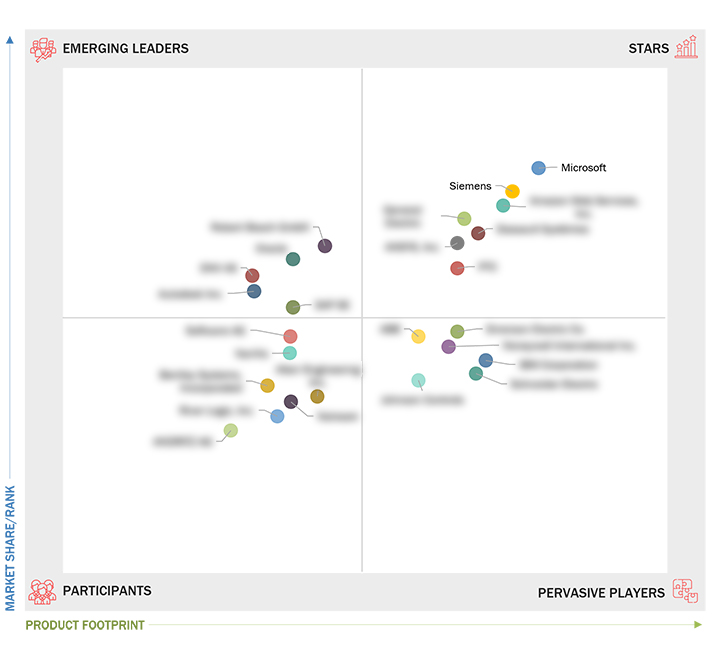Comparing 25 vendors in Digital Twin across 0 criteria.
1.1 STUDY OBJECTIVES
1.2 MARKET DEFINITION
1.2.1 INCLUSIONS AND EXCLUSIONS
1.3 MARKET SCOPE
1.3.1 MARKET SEGMENTATION
1.3.2 REGIONAL SCOPE
1.3.3 YEARS CONSIDERED
2.2.1 DRIVERS
2.2.1.1 Growing use of digital twin technology to reduce costs and improve supply chain operations
2.2.1.2 Surging demand for digital twin technology from healthcare industry
2.2.1.3 Increasing adoption of predictive maintenance model across industries
2.2.2 RESTRAINTS
2.2.2.1 High capital requirement to implement digital twin technology
2.2.2.2 Susceptibility of digital twin technology to cyberattacks
2.2.3 OPPORTUNITIES
2.2.3.1 Surging demand for advanced real-time data analytics
2.2.3.2 Increasing adoption of Industry 4.0 principles
2.2.3.3 Development of human-centered digital twins
2.2.4 CHALLENGES
2.2.4.1 Complexities associated with data collection and mathematical models
2.2.4.2 Shortage of skilled workforce
2.3 VALUE CHAIN ANALYSIS
2.4 ECOSYSTEM MAPPING
2.5 TRENDS/DISRUPTIONS IMPACTING CUSTOMER BUSINESS
2.6 PORTER’S FIVE FORCES ANALYSIS
2.6.1 THREAT OF NEW ENTRANTS
2.6.2 THREAT OF SUBSTITUTES
2.6.3 BARGAINING POWER OF BUYERS
2.6.4 BARGAINING POWER OF SUPPLIERS
2.6.5 INTENSITY OF COMPETITIVE RIVALRY
3.1 OVERVIEW
3.2 KEY PLAYER STRATEGIES ADOPTED BY MAJOR PLAYERS
3.3 FIVE-YEAR REVENUE ANALYSIS OF TOP COMPANIES, 2018–2022
3.4 MARKET SHARE ANALYSIS, 2022
3.5 DIGITAL TWIN MARKET: COMPANY EVALUATION MATRIX, 2022
3.2.1 STARS
3.2.2 EMERGING LEADERS
3.2.3 PERVASIVE PLAYERS
3.2.4 PARTICIPANTS
3.6 DIGITAL TWIN MARKET: COMPANY FOOTPRINT
3.7 COMPETITIVE SCENARIOS AND TRENDS
3.7.1 PRODUCT LAUNCHES
3.7.2 DEALS
3.7.3 OTHERS
4.1 KEY PLAYERS
4.1.1 GENERAL ELECTRIC
4.1.1.1 Business overview
4.1.1.2 Products/Solutions/Services offered
4.1.1.3 Recent developments
4.1.1.3.1 Product launches
4.1.1.3.2 Deals
4.1.1.4 MnM view
4.1.1.4.1 Key strengths/Right to win
4.1.1.4.2 Strategic choices
4.1.1.4.3 Weaknesses and competitive threats
4.1.2 MICROSOFT
4.1.2.1 Business overview
4.1.2.2 Products/Solutions/Services offered
4.1.2.3 Recent developments
4.1.2.3.1 Product launches
4.1.2.3.2 Deals
4.1.2.4 MnM view
4.1.2.4.1 Key strengths/Right to win
4.1.2.4.2 Strategic choices
4.1.2.4.3 Weaknesses and competitive threats
4.1.3 SIEMENS
4.1.3.1 Business overview
4.1.3.2 Products/Solutions/Services offered
4.1.3.3 Recent developments
4.1.3.3.1 Product launches
4.1.3.3.2 Deals
4.1.3.4 MnM view
4.1.3.4.1 Key strengths/Right to win
4.1.3.4.2 Strategic choices
4.1.3.4.3 Weaknesses and competitive threats
4.1.4 AMAZON WEB SERVICES, INC. (AWS)
4.1.4.1 Business overview
4.1.4.2 Products/Solutions/Services offered
4.1.4.3 Recent developments
4.1.4.3.1 Product launches
4.1.4.3.2 Deals
4.1.4.4 MnM view
4.1.4.4.1 Key strengths/Right to win
4.1.4.4.2 Strategic choices
4.1.4.4.3 Weaknesses and competitive threats
4.1.5 DASSAULT SYSTÈMES
4.1.2.1 Business overview
4.1.2.2 Products/Solutions/Services offered
4.1.2.3 Recent developments
4.1.2.3.1 Product launches
4.1.2.3.2 Deals
4.1.2.4 MnM view
4.1.2.4.1 Key strengths/Right to win
4.1.2.4.2 Strategic choices
4.1.2.4.3 Weaknesses and competitive threats
4.1.6 ANSYS, INC.
4.1.6.1 Business overview
4.1.6.2 Products/Solutions/Services offered
4.1.6.3 Recent developments
4.1.6.3.1 Product launches
4.1.6.3.2 Deals
4.1.6.4 MnM view
4.1.6.4.1 Key strengths/Right to win
4.1.6.4.2 Strategic choices
4.1.6.4.3 Weaknesses and competitive threats
4.1.7 IBM CORPORATION
4.1.7.1 Business overview
4.1.7.2 Products/Solutions/Services offered
4.1.7.3 Recent developments
4.1.7.3.1 Product launches
4.1.7.3.2 Deals
4.1.8 PTC
4.1.8.1 Business overview
4.1.8.2 Products/Solutions/Services offer
4.1.8.3 Recent developments
4.1.8.3.1 Product launches
4.1.8.3.2 Deals
4.1.9 SAP SE
4.1.9.1 Business overview
4.1.9.2 Products/Solutions/Services offered
4.1.9.3 Recent developments
4.1.9.3.1 Deals
4.1.10 ORACLE
4.1.10.1 Business overview
4.1.10.2 Products/Solutions/Services offered
4.1.10.3 Recent developments
4.1.10.3.1 Product launches
4.1.10.3.2 Deals
4.1.10.3.3 Others
4.1.11 ROBERT BOSCH GMBH
4.1.11.1 Business overview
4.1.11.2 Products/Solutions/Services offered
4.1.11.3 Recent developments
4.1.11.3.1 Product launches
4.1.11.3.2 Deals
4.2 OTHER KEY PLAYERS
4.2.1 EMERSON ELECTRIC CO.
4.2.2 ABB
4.2.3 HONEYWELL INTERNATIONAL INC.
4.2.4 SCHNEIDER ELECTRIC
4.2.2 NAVVIS
4.2.6 DNV AS
4.2.7 AUTODESK INC.
4.2.8 ANDRITZ AG
4.2.9 SOFTWARE AG
4.2.10 BENTLEY SYSTEMS, INCORPORATED
4.2.11 RIVER LOGIC, INC.
4.2.12 ALTAIR ENGINEERING INC.
4.2.13 JOHNSON CONTROLS
4.2.1 nSTREAM


 The Textile Magazine
The Textile Magazine
 Dec 2025
Dec 2025

